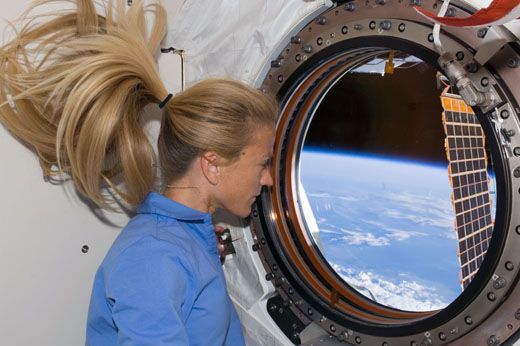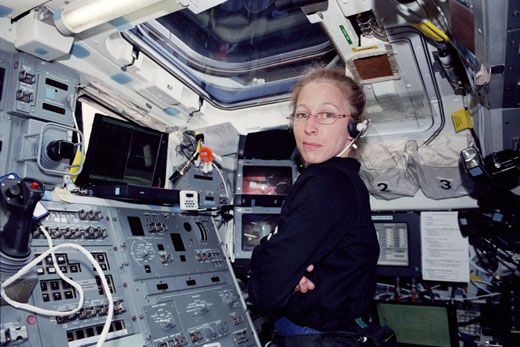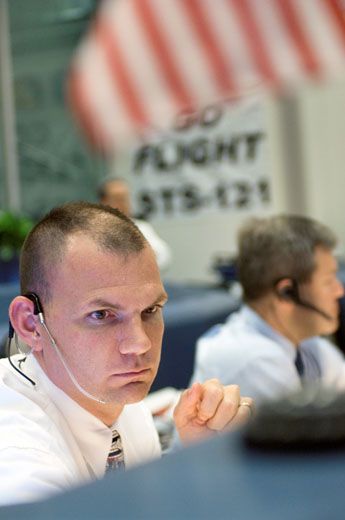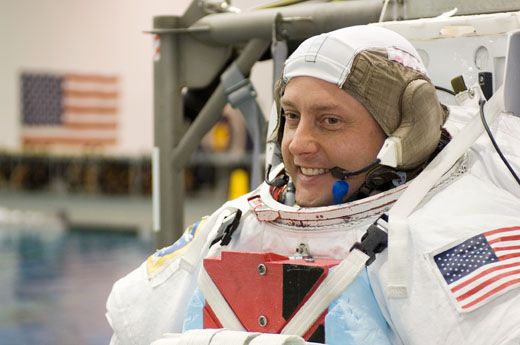Fly Us to the Moon
The next lunar explorers will soon report to Houston. Are some already there?
/https://tf-cmsv2-smithsonianmag-media.s3.amazonaws.com/filer/ON08_NextMoon_Flash_631x300.jpg)
On a warm fall day in September 1962, a young U.S. Air Force captain named Tom Stafford sat on the stage of a University of Houston auditorium with eight other men. They had just been named the second group of NASA astronauts. As reporters peppered them with questions about hometowns and families, Stafford looked to his right and left and thought, One of us is going to be the first to walk on the moon.
He was right: One of the nine was Neil Armstrong. Like Stafford, Armstrong was a member of the pioneering first generation of NASA astronauts—73 in all, selected between May 1959 and August 1969. Most were experimental test pilots. The rest were either military pilots or professional scientists who had to qualify by flying jet aircraft. They could not be taller than five foot eleven, and their eyesight had to be 20/20 without correction. The first groups had to endure a week of hellish medical tests. All were white males.
In 1978, the second generation emerged: the first group of astronauts selected to fly on the space shuttle. For them, the medical requirements were eased considerably, because the launch and entry stresses of the shuttle were more benign. The new astronauts could be as tall as six foot four and, for some, glasses or contact lenses were allowed. Fifteen of the "Thirty-Five New Guys" were test pilots, but 20 were "mission specialists"—engineers and scientists, some of whom had no piloting skills at all. None of the mission specialists had to qualify as a pilot; they only had to ride in the back of the T-38 Talon jet trainers to show that they could work effectively as members of flight crews. Six of the TFNGs were women, four were minorities. Over the next 26 years, through 2004, more groups were trained, bringing the number of shuttle astronauts to 238.
The astronauts to be picked in 2009—NASA's 20th group—will be the first of a third generation, and theirs will be a particularly daunting mission: Return America to the moon on an entirely new spacecraft. "We will no longer be flying on the shuttle," says Steve Lindsey, the four-time space flier who since October 2006 has headed the astronaut office at NASA's Johnson Space Center in Houston. "By 2011, when the new candidates complete their initial training, we won't even have the [shuttle] simulators." The 2009s will also face more restrictive physical admission criteria than the shuttle generation. Because they are being selected initially for International Space Station missions, the new candidates will have to fit in a Russian Soyuz spacecraft, which has a height restriction of six foot three. "It's not just a matter of height, but all kinds of anthropometrics: leg length, sitting height," says Lindsey. So, with NASA again planning long trips in small capsules, prospective astronauts will have to be just a bit shorter than their shuttle brethren.
As usual, NASA won't have any problem filling the astronaut ranks. In the latest call for applications, 3,535 people are vying to gain a seat in the astronaut class of 2009. A panel headed by Duane Ross, manager of astronaut selection for the past 42 years, will conduct several reviews of the pool, first eliminating those who don't meet the qualifications, then winnowing them further, looking for the right balance of achievement and versatility. About 120 applicants will be identified, and 20 at a time will be invited to Houston for a week of medical tests and interviews beginning this month. From that group, about 40 will be called back to NASA next February and March for more extensive screening. In late April, Lindsey or flight crew operations director Brent Jett will call those selected from that round, inviting them to join the astronaut team.
"We're looking at a group from 10 to 15," says Ross. "The final number will depend on how big the astronaut office is at the time we make the decision." There are now 90 active-status astronauts, but by the time the 2009s are eligible for flight assignment, the number is expected to shrink to 60. Once the last shuttle crews are named, next May or June, attrition may increase, since those remaining have to compete for slots on the three-seat Soyuz flying to the space station.
Since NASA began selecting women as astronauts 30 years ago, it has never chosen fewer than two in each astronaut group. Based on past experience, expect a third of the 2009s to be female. There will be a similar number of minority candidates. And while eight to 12 of the new astronauts will be scientists, engineers, or current NASA employees (with overlap among the categories), three or four will come from the traditional test pilot community. According to Lindsey, a former test pilot, "They are pilots, they've been in operational squadrons, some have been in combat. They have been through test pilot school and have worked on flight test programs. They come to the astronaut office with the ideal background."
But NASA wants more. "It's vital for us to have a variety of skill sets and points of view in the astronaut office," says Lindsey. "When you put test pilots together with scientists, both sides learn. Pilots need to learn science, scientists need to learn operational skills."
The 2009s will also differ from the shuttle-era groups in that they'll drop the distinctions between flight duties. "We've eliminated the caste system," says veteran shuttle astronaut Marsha Ivins. Instead of having titles like "pilot" or "mission specialist," the new astronauts will all be simply "operators." There won't be any teachers-in-space, either; NASA dropped the "educator mission specialist" classification last year. "Educators will be welcome," says Ross, "but they will be competing, the same as everyone."
Beyond Soyuz flights to the space station, the new astronauts can look forward to the Constellation program and the Orion spacecraft. "Constellation is the mission to get us back to the moon," says Mark Geyer, Orion project manager. "Orion is the element that allows us to continue operating in low Earth orbit, flying crews and supplies to the International Space Station beginning in 2015, then allowing us to go onto the moon."
Constellation's other components include the Ares I and Ares V rockets, the Earth Departure Stage, and the Altair lunar lander. Along with Ares I, which is based on the shuttle's solid rocket booster, the Orion crew module is the most developed of the elements (see "Orion's Brain," Sept. 2007). Orion is shaped like the Apollo command module but is 50 percent larger and can carry six people to low Earth orbit, or four to lunar orbit.
"No one at NASA has designed a new manned vehicle in over 30 years," says Ivins, who heads the astronaut office's Constellation branch. "A whole generation has never had that experience." But the new generation of astronauts will be part of the design process, just as the Mercury astronauts were. Randy Bresnik, a Marine test pilot in the 2004 astronaut group, currently is helping shape Orion's design. "The spacecraft should take the workload off the crew for mundane tasks," he says. "In the shuttle, you spend a lot of time training to go to the right page in a thick flight data file. Orion operators should only do the things a computer can't do." Still, Bresnik says, there remains a role for "pink squishy bodies" in space. "We know where to look when there's a problem."
The 2009s will be certified as full-fledged astronauts in 2011. By then, they will already be working on technical assignments—as capsule communicators, or capcoms, or as crew support astronauts for station missions, payloads, hardware, spacewalks, and robotics. And they will be obsessing over this question: Will I get to go to the moon?
One problem confronting them will be a lack of flight opportunities. Through the shuttle era, new astronauts could expect to make three to five flights in an active career that averaged a dozen years. "In some years, we had 50 different astronauts in space," says former shuttle astronaut Jeff Hoffman. "With Orion and ISS, that number will be more like a dozen. The new candidates will be looking at one or two flights at most in their entire career." It's a model that recalls the Apollo era.
But this generation will differ from its predecessors in one key area. According to Andrew Chaikin, author of A Man on the Moon, the Apollo astronauts did little reflecting on or sharing of their experiences; they were too concerned with timelines, and they often were simply uninterested in doing so by temperament. After all, they were pilots, not poets or geologists. "You had to do the 'exploring' in order to get to do the flying," Apollo 12 commander Pete Conrad told Chaikin.
From the first Mercury missions onward, NASA was open about its activities, but was often clueless about the benefits of better communication with the public. Stafford wanted to carry a color-TV camera on Apollo 10 (earlier Apollo missions had used black-and-white cameras), but he found NASA tremendously resistant. Even shuttle astronauts were not universally eager to communicate the wonders of exploration, or to explore at all. Former astronaut Tom Jones recalls that when he would give informal seminars on new developments in astronomy, or futuristic missions like manned asteroid flybys or comet landings, a small but notable element within the pilot ranks would react with bafflement or indifference. "Who cares about a blasted hunk of rock in space?" one asked.
The 2009s, on the other hand, will be cut out for show-and-tell. Says Chaikin, "If the Baby Boomers are the 'Me Generation,' those who are in their 20s and 30s now are the 'Look-at-Me Generation.' They are more comfortable being on stage and sharing their experiences with blogs and YouTube. The Orion-Altair astronauts will face the same pressures of timeline and checklists the Apollo men did, but their missions will be longer. They will have time to reflect, then relate their experiences to those of us on Earth. They understand that they represent those of us who can't go." Some of the recent space station crews understand that; several station astronauts have written blogs while in orbit.
No matter how media-savvy the new astronauts are, they'll find that the Constellation program presents challenges and opportunities that dwarf Apollo in complexity and ambition. For one thing, the Altair lander is only one of three basic vehicles on the drawing board; there's also an outpost and a pressurized logistics module. Based on the Altair design, the outpost will provide living quarters for four astronauts during lunar missions lasting 14, 28, or even 180 days.
The logistics module will provide needed supplies and other equipment, such as a pressurized lunar rover or a crane to transfer cargo. The design is immensely complicated by the twin goals of sustainability and operability. "All equipment has to be able to work in three modes: with an astronaut in control, remotely from mission control, and independently," says Chris Culbert of the lunar surface systems office. Mobility is key. "It's not just moving from point A to point B, it's being able to do something once you get there," he says.
The NASA that the new candidates will be joining is a more jittery organization than the one that greeted earlier classes. In the wake of the 2007 scandal in which shuttle astronaut Lisa Nowak was charged with assaulting a rival for the affections of another astronaut, the 2009s will face greater psychological testing than their predecessors, though, Duane Ross points out, "We already spend more time in the interview week on that subject than on any other."
Patricia Santy, a former NASA medical officer, says that the problem isn't the initial interview. It's lack of follow-up. "The assumption is that once you've been selected as an astronaut, you're good," she says. "Yet what happens after selection is what changes astronauts most dramatically. They are placed in a narcissistic-enabling environment, treated like gods. You have situations where experienced, senior people in medicine are overruled by people just out of med school just because they happen to be astronauts."
Hoffman doubts that follow-ups are the answer. "People who are clever enough to get past the first screening will be clever enough to pass the follow-ups too," he says.
Nevertheless, astronaut managers continue to gather data on the traits that are best suited for this dangerous yet attractive profession. Behavioral scientist Jack Stuster, author of Bold Endeavours, a 1996 study of historic exploratory missions and a frequent lecturer at the astronaut office, has a continuing study of space station crew members that builds on earlier work with Navy personnel and civilians on Antarctic research teams. "When it came to ranking the traits desirable for fellow crew members, Navy personnel ranked emotional control first, followed by compatibility," says Stuster. "Civilians had them reversed: Compatibility was most important, followed by emotional control. But both groups put technical proficiency third."
Compatibility is important at Johnson. Says Lindsey, "The primary purpose of the astronaut interview is to ask yourself, 'Could I spend 14 days locked up in a Winnebago with this person?' " NASA tackles the compatibility issue by putting astronauts under stress throughout their careers. "One of the most useful programs we have is sending astronauts to the National Outdoor Leadership School," says Lindsey. "You spend around 12 days in places like the Wind River Range or Canyonlands in Utah, learning about self-care and buddy-care, interpersonal stuff, working as a team."
A second phase uses the NASA Extreme Environments Mission Operations (NEEMO) program, in which teams of astronauts and engineers work in the underwater Aquarius lab off Key Largo, Florida. "These are great analogs for shuttle missions," Lindsey says. "Eleven, 12, 14 days where you do scuba dives, which are just like EVA [extra-vehicular activity—spacewalks]. NEEMO missions will also be relevant to lunar missions. In fact, we're doing research now in suits for lunar EVAs, learning about suit weight and center of gravity."
If compatibility is what makes a successful mission in an extreme environment, like the space station or Orion, should NASA be choosing people who have proven themselves in similar situations: submariners, deep-sea divers, oil rig workers? Hoffman, who has a doctorate in astronomy and was one of the spacewalkers who in 1993 repaired the Hubble Space Telescope, doesn't think so. Referring to the 1998 movie Armageddon, in which oil riggers are sent into space to divert an Earth-threatening asteroid, Hoffman says, "With all due respect to Bruce Willis, it's a lot easier to train a Ph.D. to do EVA than it is to train a construction worker to handle the technical requirements of spaceflight."
What about the possibility that the next lunar explorers won't be NASA astronauts? Could oil-rich Russia ignite a second moon race? Officials in Roskosmos, the Russian air and space agency, have spoken about the possibility, but no program has been announced or funded. NASA Administrator Michael Griffin has said China might beat America back to the moon—technically possible, given the development of its Long March 5 booster and a lunar lander. But the Chinese government has made no pronouncements about manned missions beyond Earth orbit.
One thing the next moonwalker won't be is a commercial astronaut, like Mike Melvill or Brian Binnie, the pilots of SpaceShipOne, which won the Ansari X-Prize for the first private manned spaceflights. There may well be dozens, possibly hundreds, of people who earn astronaut "wings" as passengers on Virgin Galactic's suborbital flights to an altitude above 62 miles. And by 2019, we may have seen commercial astronauts from Bigelow Space, SpaceX, or Orbital Sciences in Earth orbit. But according to NASA's Ross, they won't be flying to the moon by then. "It will be business as usual," he says.
While the class of 2009 will likely provide at least one member of the next lunar team, others may well be working in Houston already. Experience would be important to a lunar expedition, and NASA has tended to give command of a new vehicle to veterans. For example, long-time astronaut John Young was commander of the first space shuttle flight, in 1981, at age 50. Young had already flown twice on Gemini and twice on Apollo and had walked on the moon. For his Columbia crewmate, Bob Crippen, who was named an astronaut in 1969, the shuttle launch was his first trip to orbit.
Current astronauts Jim "Vegas" Kelly, a two-time shuttle pilot, and three-time flier Pam Melroy, who is working on Orion development, have both expressed a desire to fly Orion missions. Pilots Scott Kelly and his twin brother Mark are also mentioned as committed to long-term careers at NASA. Astronaut Peggy Whitson, veteran of two space station expeditions—one as mission commander—is another astronaut believed to have a long-standing interest in exploration. By the time of the first lunar flights, however, all of these veterans would be in their mid- to late 50s. Not an absolute disqualifier, but certainly a factor. Andy Thomas, for instance, describes himself as "too young for Apollo, too old for Altair."
It's more likely that the Orion-Altair crew of 2019 will come from those astronauts around age 40 today. They number only a dozen of the active members of the astronaut office, including pilots like Bresnik and Tony Antonelli, Terry Virts, and Jim Dutton, and mission specialists like Tracy Caldwell, Megan McArthur, Karen Nyberg, Robert Behnken, and Mike Fincke. All have either helped in the Orion design or will be asked to, though an astronaut's technical assignment now is a poor indicator of a future flight assignment, especially when such decisions are years away.
Fincke, who attended a summer exchange cosmonautics program at the Moscow Aviation Institute before becoming an astronaut and an Air Force flight test engineer, is constantly mentioned in conversations with NASA insiders and informed observers as a likely member of the next lunar crew.
Of course, this is speculation. The lunar astronauts won't be named for another decade—and that's if NASA's moon plans stay on track. What's certain is that sometime next May, a dozen men and women will be sitting on a dais in a NASA press conference in Houston or in Washington, D.C. Some may well have their own Stafford moment, looking right, then left, and thinking, One of us is going to be the next to walk on the moon. And then they'll probably blog about it.



